

New HCP Service (Beta) - SAP Data Quality Manag... SAP Data Quality Management, microservices allows developers to embed data cleansing and enrichment services within any business process or application with a self-service, right-sized consumption model.
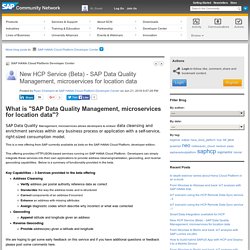
This is a new offering from SAP currently available as beta on the SAP HANA Cloud Platform, developer edition. This offering provides HTTP/JSON-based services running on SAP HANA Cloud Platform. Developers can simply integrate these services into their own applications to provide address cleansing/validation, geocoding, and reverse geocoding capabilities. Below is a summary of functionality provided in the beta. Key Capabilities – 3 Services provided in the beta offering We are hoping to get some early feedback on this service and if you have additional questions or feedback please post some comments here. We are planning to provide pre-built integrations of these services in other applications from SAP which will provide a very simple way to consume this functionality. Data Services: 1. 2. The New Age of Analytics – HCP &&... SAP recently launched SAP Cloud for Analytics (C4A) a Software-as-a-Service (SaaS) offering natively built on the SAP HANA Cloud Platform.
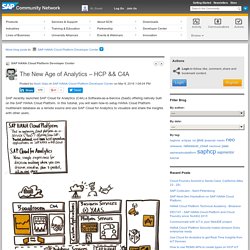
In this tutorial, you will learn how-to setup HANA Cloud Platform multitenant database as a remote source and use SAP Cloud for Analytics to visualize and share the insights with other users. Prerequisites Access to trial landscape, you need to have a developer account first. If you still need to create a developer account, you can start from here: Signing Up for a Developer Account.Access to Cloud for Analytics trail account, to register you can start from here: Discover Cloud For Analytics. Instructions To create and configure a trial tenant database, follow these steps: Log on to the SAP HANA Cloud Platform cockpit and select an account.Choose Databases & Schemas from the menu on the left.
NOTE* If there are no free resources available you will not be able to create a tenant database. 5. Now you have your tenant database created and configured. 6. 7. The New Age of Analytics – HCP &&... HANA Cloud Platform - Setting the stage (Pa... Welcome back to this mini series about SAP HANA Cloud Platform (HCP).

In part 1 we provided you with a high-level overview about PaaS in general and HCP in more detail. Based on this knowledge we can now dig deeper and see how some of the recent announcements fit into the bigger picture. Open PaaS It is essential to understand SAP's vision in regards to PaaS to fully grasp the relevance and the importance of the things we'll discuss in this blog post. So, let's have a brief look back at the early days before we fast forward to today (and beyond).
In the beginning of SAP's PaaS journey there's been the conscious decision to start from scratch and develop a cloud platform based on open standards and open source software. In simple terms this philosophy boils down to: only differentiate in areas where there is no prior art and where differentiation adds value! Information Tools & SDKs Education Code samples Communication Last, but not least: communication. Cloud Computing: SAP HANA Cloud Integration.
Ben Hofmans, HANA Cloud Integration product owner, more specifically for Data Services provided this ASUG webcast.
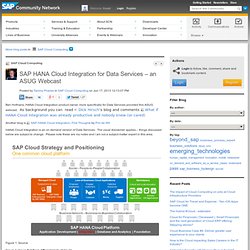
As background you can read Dick Hirsch’s blog and comments What if HANA Cloud Integration was already productive and nobody knew (or cared) Another blog is SAP HANA Cloud Integration, First Thoughts by Pim de Wit HANA Cloud Integration is an on demand version of Data Services. The usual disclaimer applies – things discussed below are subject to change. Please note these are my notes and I am not a subject matter expert in this area. Figure 1: Source Figure 1 shows that there different kinds of clouds Integration is important in all cloud types On the left of Figure 1 is the Managed Cloud where SAP provides hosted version of software - HANA Enterprise Cloud is an example – you get a HANA box – it is not in your network, you don’t acquire hardware or maintain.
There are many clouds. 8 Easy Steps to Develop an XS application on th. Disclaimer: This document relates to Beta functionality available on SAP HANA Cloud Platform trial landscape.
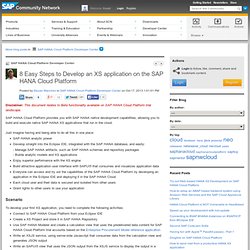
SAP HANA Cloud Platform provides you with SAP HANA native development capabilities, allowing you to build and execute native SAP HANA XS applications that run in the cloud. Just imagine having and being able to do all this in one place: SAP HANA analytic powerDevelop straight into the Eclipse IDE, integrated with the SAP HANA database, and easily: - Manage SAP HANA artifacts, such as SAP HANA schemas and repository packages - Builde analytic models and XS applications Scenario To develop your first XS application, you need to complete the following activities: SAP HANA Cloud Platform. Get your own SAP HANA, developer edition on Clo. You can now create your own HANA developer environment on CloudShare!
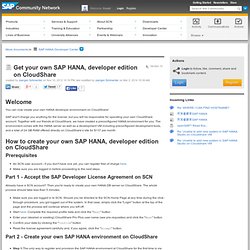
SAP won't charge you anything for the license, but you will be responsible for operating your own CloudShare account. Together with our friends at CloudShare, we have created a preconfigured HANA environment for you. The environment comes with the HANA server as well as a development VM including preconfigured development tools, and a total of 24 GB RAM offered directly on CloudShare’s site for $137 per month. Prerequisites An SCN user account - if you don't have one yet, you can register free of charge here.Make sure you are logged in before proceeding to the next steps.
Developer Center HOWTO - Get and Install a SAP. Welcome If you followed the instructions on Developer Center HOWTO - Get and Install a SAP HANA, developer edition License File to create your own HANA instance on one of our public cloud partners, you will have to renew your license key every 90 days.
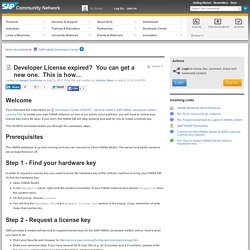
If you don't, the HANA DB will stop working and wait for you to install a license key. This HOWTO document walks you through the necessary steps. The HANA database is up and running and you can connect to it from HANA Studio. The server and studio versions are at least Revision 35. In order to request a license key, you need to know the hardware key of the (virtual) machine running your HANA DB. Open HANA StudioIn the Navigator panel, right-click the system connection of your HANA instance and choose Properties from the context menuOn the popup, choose LicenseYou will find the Hardware Key in the Request License Key section of the popup.